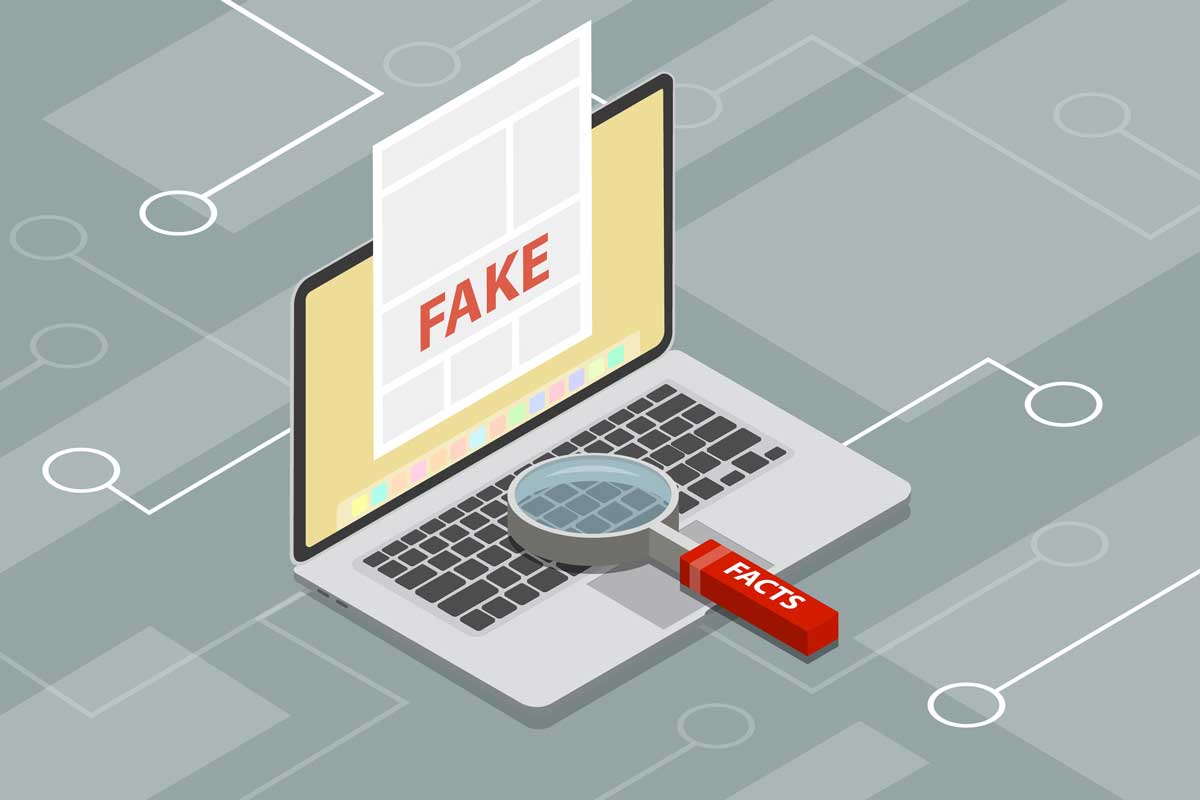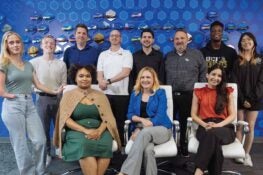The term “fake news” has become so ubiquitous in our society that it’s even become a punchline. But the threat is very real — with real consequences — which is why UCF Associate Lecturer of Psychology Chrysalis Wright dedicates her days to studying it.
Wright is an expert on fake news and online disinformation who serves as the founding director of UCF’s Media and Migration Lab, which identifies and develops methods for fighting fake news. She was recently appointed to the board of directors for the United Nation’s Communications Coordination Committee, which aims to improve communications across cultures globally.
“The more we do research on the impact of fake news, the more we can see how it’s impacting society as a whole,” Wright says. “We tend to think that our opinions, attitudes and beliefs are our own, but that’s not 100 percent correct because we’re influenced by what we see. Fake news absolutely influences our attitudes, our beliefs, and we also know that that can influence our actual behavior.”
Here, she explains what we need to be aware of and the impact of fake news on the upcoming election.
How has fake news and disinformation affected our elections?
CW: When the 2016 election was approaching, what we encountered was foreign entities infiltrating our social media. We know at this point that Russia was involved in some of this, but there’s other countries that likely had a role, as well. They would create fake news and share it on our social media platforms.
The intent of their posts is very clear. They pick hot topics that we are divided on and still discussing as a nation — such as gun rights, race relations, immigration issues — and use that as a weakness against us. Their entire purpose is to divide us and make us fight each other from within, because if they can get us to fight each other from within, they don’t have to do anything; they’re already winning. And they’ve been very successful. If you look at the social unrest that you see on some of our streets today, part of this is related to some of the fake news that’s been spread.
As far as the 2020 election, there has been some speculation that we might see some foreign interference from Russia, China, as well as Iran. But we will actually not be able to determine how fake news impacted the current election until after the fact. Hopefully, we’ve learned from what took place in 2016.
How popular and widespread are fake news stories?
CW: Right before the 2016 election, the top 20 fake news stories that were circulating on social media received more engagement — so that’s liking, sharing, commenting — than the top 20 factual news stories that were on social media.
How has fake news influenced voters?
CW: We’re still trying to find out how much of an influence it has on how moderate or undecided voters cast their vote at the poll. There was a research study that said undecided voters were more likely to vote for President Trump in the last election if they believed the fake news about Hillary Clinton that they saw on social media. When elections are close, like it was in 2016, that’s when we’re likely to see fake news impact the outcome of the election.
Right now, we are seeing an increase in political fake news on social media as we get closer to this year’s election. And we’re going to continue to see it until after the election, and after all of the votes are counted.
How has fake news impacted the public’s relationship with the U.S. government?
CW: There are some estimates that around 70 percent of Americans feel that fake news has impacted their level of confidence in the government. We can see that’s going to impact their level of confidence in the upcoming election. We already saw some kind of hubbub about that — that the election is rigged before it even started.
Are certain demographics more susceptible to believing fake news?
CW: Yes, we do see some patterns. Generally, research has found that those who are age 65 or older tend to be more susceptible to believing fake news. Those who are very hard-right conservative are more likely to believe fake news. And part of that comes from just a general distrust in mainstream media that they’ve developed over the past couple of years. White males are more susceptible to believing fake news. And then those from a lower socioeconomic background are more likely to believe it. Those who are less educated are more likely to believe it.
The research that we’ve done here at UCF has focused on college students. We see similar trends among college students [as we do among the elderly], but there are some differences, as well. College students still struggle with identifying fake news when they see it on social media. We’ve found students from higher social class backgrounds are more susceptible to fake news. We do also see that those who are more conservative who have high levels of what we call right-wing authoritarianism are more susceptible to believing fake news. Males are still more susceptible to believing fake news, in our research, as well as participants who identify themselves as white.
What are some tips for discerning between real news and fake news?
CW: The first thing I would say is don’t get your news from social media in any way. Please don’t do that. Get your daily news from either local or national reputable news sources.
“Don’t get your news from social media in any way. Please don’t do that.”
Pay attention to the headline. If it’s very sensational, most likely it’s false. Pay attention to how popular it is. How many times has it been liked or shared? Just because something is popular, doesn’t necessarily mean that it’s true.
If you’re able to identify the source of the post, try to do your own fact-checking, which is one of the things that we struggle with — because oftentimes, we may only read the headline and not the whole story and just keep scrolling. We’ve created an environment where we want information automatically, and it’s very hard sometimes to pause and read the actual story, and then fact-check the story, check the sources. Is this really what they said? Is this really what they meant? That requires effort on our part, and we owe it to ourselves to put forth that effort.
How can you distinguish between fake news, biased reporting and hard news?
CW: We need to make sure that we understand the difference between biased reporting and fake reporting. CNN and Fox are both be examples of biased reporting. One is very hard left and the other is very hard right. Because of this, the stories they report are often biased.
There are reputable news sources out there, even if someone tells you that they’re considered false, because they don’t agree with what’s being reported. That’s how the term “fake news” is being tossed around these days — if it doesn’t agree with your view, you just say, “Oh, that’s fake news. Ignore it.” But that’s not what fake news is. Everyone is entitled to their opinion, but I tell students in my class, it should be an educated opinion. You should have facts and figures and sources to support the views that you hold. In fact, the views that you have should be based on facts and sources that you’ve read. The New York Times is not a fake news source. The Washington Post, Wall Street Journal and Associated Press are excellent news sources. NBC News is pretty good. We should be able to rely on our news sources to present us with science and facts and current advances, especially now in the middle of COVID.
Social media sites are starting to label fake news or take down posts. Is this enough? What else can be done to stop the spread of fake news?
CW: I like the fact that social media platforms themselves are trying to do something, but unfortunately, at this point, it’s not enough. When Twitter and Facebook mark something as misleading or containing false information, it’s not the most effective strategy because it’s usually not getting to the people who need to see it. And this is also where people get confused about the First Amendment. Yes, the First Amendment protects free speech, but the majority of fake news is created outside of the U.S. by foreign agents, which means it is not protected by the First Amendment. And these platforms, as well as our lawmakers, have every right to be able to take that down because it’s speech happening not on U.S. soil. It’s created by a foreign entity with the intent on dividing us.
Unfortunately, at this point, I can’t say that I think educating consumers is the best way, either. There have been tons of resources out there to help people understand what fake news is, how to identify it and prevent it from influencing them for a while now, but it’s not very effective.
We need to do more. Because if people don’t have accurate information, they’re not going to be able to make the best decisions. They’re going to be making decisions based on lies.
What would be more effective is if our lawmakers actually take action. If lawmakers could consider regulating digital campaign advertisements on social media and search engines, identifying geo locators to make sure that what’s being posted is by real people, and identifying the people who are posting that information. We also need to have lawmakers making sure that we have increased transparency in how consumer data is actually used by these social media platforms. Most people don’t read the terms of agreement, they just scroll down and hit agree. But we need to be more transparent in how our personal information is being used by social media platforms.
How does your work with the UN draw from or expand upon your research efforts regarding fake news?
CW: The goal of the Communications Coordination Committee is to promote an understanding of world problems and their solutions. In order to do this, we need to have accurate information about world problems and base solutions on science, evidence and facts. This is where an understanding of fake news comes in. Understanding the impact of fake news related to real world problems, such as COVID-19, will help ensure that we have a firm understanding regarding current world problems and will help establish solutions based on science and fact. Right now, I am helping plan a panel discussion on the topic of disinformation, fake news, stereotypes, persuasive media and its impact on consumers. I will continue to engage in efforts such as this in my role as a board member.





